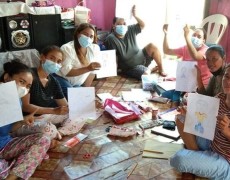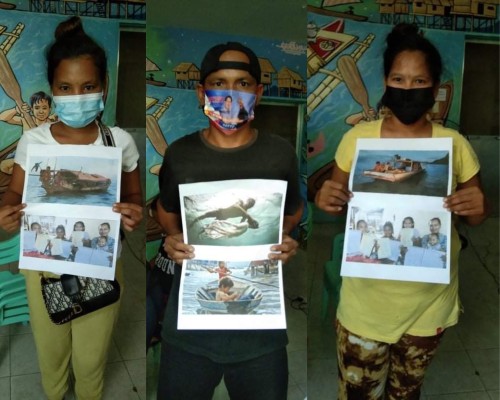Kuwentuhang Karapatan Sessions: Community Conversations on Safeguarding Children’s Rights with Sama-Bajau Parents, Teachers, and Community Members

by Cale Belyn Cruz
Everyone has the right to live freely and safely, especially children who are among the most vulnerable groups in society.
Cartwheel Foundation engaged selected Sama-Bajau parents, teachers, and community members from Zamboanga and Parañaque in a series of learning conversations on safeguarding held on March 23, May 18, and May 25, 2022. The participants performed the activities in a face-to-face set-up guided by community-based teachers and learning facilitators with the main facilitator from Cartwheel joining through Zoom. Each session tackled key themes connected to the pillars of children’s rights namely the right to survival, protection, participation, and development. These safeguarding sessions aim to develop, share and articulate how Sama-Bajau value and protect their children.
Through *Consuelo Zobel Alger Foundation’s support, Cartwheel was able to seed a deeper understanding of safeguarding children’s rights with Sama-Bajau parents, teachers, and community members.
Session 1: Defining Caring for Our Children
On March 23, 2022, the first session started by delving into the concept of a child, safe spaces/environment, and safe relationships. These concepts were generated through art-based activities which involved participants imagining, drawing, and sharing their ideas and insights with each other.
The discussion highlighted that children have their own rights which are foundational to upholding and safeguarding them. Apart from having the right to education, freedom of expression, and health services – children have the right to live freely and safely.
Safeguarding involves protecting their children from different kinds of abuse (physical abuse, sexual abuse, sexual exhibitions, and inuendos). Participants identified the home and parents as the first line of defenders from abuse with the second line of protection being their children’s schools and trusted guardians. As one participant mentioned, “children can actually understand and remember when they are reminded of the things that can put them in danger so constant guidance can keep them safe to help them make the right decisions.”
The session ended with the participants affirming their commitment to ensuring children’s safety by educating their children and each other as well as their wider community to become safe spaces.

Through their drawings, participants express their commitment to providing and ensuring safe spaces for children at home, at school, and in their community.
Session 2: Understanding Survival and Protection
On May 18, 2022, the second session on safeguarding continued with the discussion on two pillars of children’s rights: survival and protection. For each theme, several images were presented to the participants and they were asked to identify which ones resonated with them.
In times of survival, the participants’ top priority are their loved ones, especially their children who are in need of food and shelter. Survival in the Bajau’s local language is asannang ma kasusahan. Among the images selected symbolizing survival were food and a boat which represent both security and safety. As most of the participants narrated, after the siege in Mindanao, they evacuated their homes often sailing via boats to safe places such as the evacuation centers.
Meanwhile, the most favored image to represent protection or kasanyangan was a birth certificate serving as a symbol of their identity and sense of belonging in society. As explained by the participants, a birth certificate ensures their children’s future is protected because it allows them to seek health services in a hospital and enroll their kids in school to obtain an education.
The session ended with participants dancing igal-igal as an affirmation of their commitment to ensuring their children’s survival and protection. From this session, participants were able to identify different ways they have safeguarded their children’s rights.

Participants show their chosen images symbolizing survival (“Asannang ma Kasusahan”) and protection (“Kasanyangan”) namely a boat, a birth certificate, and an octopus, among other images presented during the session.
Session 3: Discussing Participation and Development
On May 28, 2022, the third and last safeguarding session focused on participation and development. Images were used as a tool for participants to reflect on their experiences of participation and development. They shared their stories and gained deeper insight into each others’ experiences during the group discussion.
One of the images highlighted to capture participation or meya-meya is children partaking in community activities and events. Participants highlighted the importance of children’s feeling of belonging in their community.
Equal to that is the ability of the parents to listen and engage their children to help them develop and succeed in the fields of their interests such as attending school. Parents cater to their children’s development or ikahapan by supporting their dreams and prioritizing their health.
Although there are challenges to safeguarding their children’s rights such as lack of income and job security, the participants find ways to provide for their children’s needs and ensure their safety. They are also not alone in safeguarding children’s rights as various organizations such as Cartwheel, the Department of Social Welfare and Development-National Capital Region (DSWD-NCR), and local government units, among others, provide them with support and help.
The session ended with participants showing their commitment to safeguarding children’s rights through their artwork. The majority of them drew food as a symbol of their love, care, and support for their children’s safety, well-being, and overall welfare.
These safeguarding lessons further exhibited the importance of a safe environment and safe relationships for children. As they say, it takes a village to raise a child, safeguarding starts at the home but extends into the whole community.
—
*Consuelo Zobel Alger, whose generosity and genuine love for children allowed us to renew hope for those who have lost it and give hope to those who never had it.
Since 1987, Consuelo Foundation has been taking action for our children and their families—uplifting one child, one family, one community, at a time.
Consuelo Foundation’s Life Skills Plus program empowers children and youth through educationand skills training so they, too, can lead, dream, and reach their full potential—and make a difference in our world. This program provides the learners with relevant learning materials to ensure sustained access to quality education. Children and youth are assisted with essential interventions to further build their knowledge, skills, and competencies to be empowered individuals.
For inquiries and info about Consuelo Foundation and this project, you may email: ask@consuelo.org or visit their social media accounts on Facebook and YouTube.

